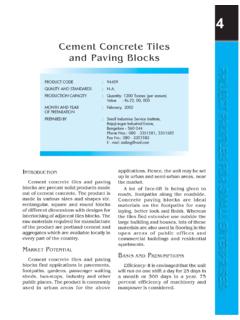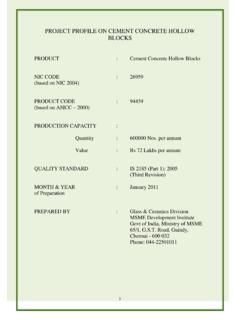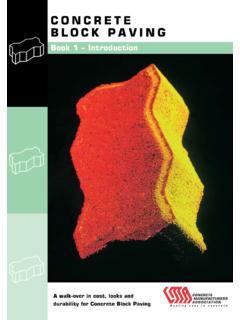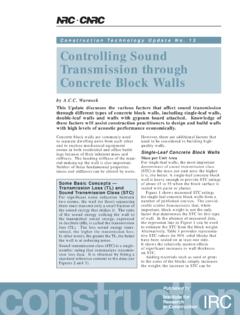Transcription of Aggregate Concrete Blocks A Guide to Selection & …
1 Concrete block Association60 Charles Street, Leicester LE1 1 FBTel: 0116 253 6161 Fax: 0116 251 4568 Email: Concrete BlocksA Guide to Selection & SpecificationIntroductionThis Guide has been produced to assist designers and specifiers with the Selection and specification of building Blocks , which are manufactured in accordance with BS EN 771-3. The appropriate CBA Data Sheets should be consulted for more detailed information, including the Selection of the UHB (Universal Housing block ) for housing projects. BS EN 771-3 contains many more properties than its predecessor BS 6073-1 but not all these are required for use in the UK. Therefore only those properties specifically needed for an application should be should be taken to ensure that the mix of properties specified are mutually compatible and therefore available in a single block SpecificationFor convenience Blocks may be categorized using the following block details for all specifications: block description ( standard common Blocks ) Dimensions ( 440mm x 100mm x 215mm) Tolerance category ( D1) Strength ( N/mm ) Net dry density ( 2000kg/m ) Configuration ( solid/Group 1)Within these categories there are three configurations, solid, cellular and hollow.
2 See DescriptionBlock types are available in various ranges produced by CBA manufacturers, which may be generally described as follows:Standard common blocksBlocks suitable for general building work, offering excellent all round performance and normally available in 440 x 215mm face size. In addition to their loadbearing capabilities, they provide an excellent background for plastering and rendering as well as for fixings. This type of block is not normally intended for use in facing applications as variations in colour and texture may textured/Paint grade common blocksBlocks manufactured with a close texture and suitable for direct facing blocksBlocks manufactured for applications where shape and texture consistency are of prime importance.
3 Slight variations in colour may be masonry facing blocksBlocks manufactured to high standards of dimensional accuracy and consistency of colour and texture. The Blocks are intended for use in situations where the visual appearance of the wall is of primary concern. The Blocks are available in a range of colours, textures, finishes and back for Special block sizes/co-ordinating dimensionsAggregate Concrete Blocks are typically available in two standard face sizes (length x height) of 440 x 215mm and 390 x 190mm. Other face sizes are available to aid manual handling. To obtain the co-ordinating dimensions add the specified joint thickness (normally 10mm) to the height and length of the dimensions should be specified in the order length x width x widths may be available from some blocksBlocks which contain one or more formed voids which do not fully penetrate the block .
4 (Group 1 or Group 2 according to void percentage.)Solid blocksBlocks which contain no formed voids.(Group 1)Hollow blocksBlocks which contain one or more formed voids which fully penetrate the block .(Group 1 or Group 2 according to void percentage.) Blocks are available in various strengths and surface TypesDimensions of commonly available Blocks are:WidthFace size (mm)440 x 215390 x 19075-9090100100140140190190215-Uniclass CI/SfBEPICL3221:A4F611:X221Ff2(Ajv)April 2007 Data Sheet 1A Guide to Selection & SpecificationSpecial BlocksBlocks produced to form an extensive kit-of-parts which gives the designer-specifier greater BeamQuoin/ReturnCavity closersFixing/CoursingVisit for the latest information, news and views from the Technical Helpline 0116 222 1507 The Concrete block Association 2007 Although The Concrete block Association does its best to ensure that any advice, recommendation or information it may give is accurate, no liability or responsibility of any kind (including liability for negligence)
5 Is accepted in this respect by the Association, its servants or datasheet is manufactured from ECF (Elemental Chlorine Free) pulp sourced from certified or well managed forests and plantations. It is totally recyclable, biodegradable and tolerancesTolerances permitted by BS EN 771-3 are:Tolerance CategoryD1D2 Length+3+1-5-3 Width+3+1-5-3 Height+3+2-5-2 Limiting deviations in will generally be supplied to D1 tolerance category unless otherwise are permitted to supply to tighter tolerances on any dimension within a tolerance StrengthsBlocks are available in compressive strengths from to 40N/mm (Solid) and to (cellular and hollow). Common strengths are and.
6 DensityAggregate Concrete Blocks are available in the net dry density range of 650 2400kg/m with a tolerance of 10%.The full range of densities will not necessarily be available from all dry densities are typically used for cellular and hollow units and for the same products will be lower than net dry to BS EN 771-3: Aggregate Concrete masonry units will fall within one of the 4 groups specified in BS EN 1996-1-1: Eurocode 6 Design of masonry 1 < 25% formed voids Group 2 > 25% < 60% formed vertical voids Group 3 > 25% < 70% formed vertical voids Group 4 > 25% < 50% formed horizontal voidsGenerally units will fall within Group 1 and Group 2 Details (when relevant) block description Density or unit weights Flatness of surface (only applicable to facing units) Thermal resistance Durability Water absorption (not required for specification in the UK) Moisture movement (not required for specification in the UK) Water vapour permeability (not required for specification in the UK) Reaction to fire (designated non-combustible by UK Building Regulations)
7 Shear bond strength (not required for specification in the UK) Flexural bond strength (not required for specification in the UK)







